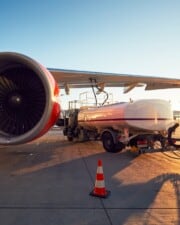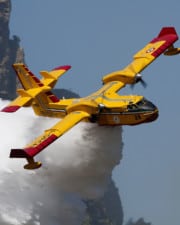When it comes to the different types of aircraft fuels, the terms “kerosene” and “jet fuel” are often used interchangeably. Despite this, they are two very different types of fuels with their own uses both within and outside the aviation industry. So what’s the difference?
Jet fuel is a type of fuel specifically designed for use in jet engines. By contrast, kerosene is a general term used to describe many different types of fuel that are chemically similar but have different real world applications. Chemically-speaking, jet fuel is a type of kerosene.
Related: What is Sustainable Aviation Fuel? | Kerosene vs Avgas
What is Jet Fuel?
Jet fuel, occasionally known as aviation turbine fuel (ATF), is a type of aviation fuel derived from crude oil. It is specifically designed for use in jet engines that operate at high speeds and altitudes.
It was first formulated back in WWII, when aircraft engineers designing and building the first jet engines realized that fuel types used in other aircraft types were not as effective when burned in a jet engine.
Like other types of aviation fuel, jet fuel is produced through a process known as fractional distillation.
Unlike other types of aviation fuel, however, jet fuel has a higher flash point and lower freezing point, making it better suited to the high altitudes and performance jet engines need to have.
Much like kerosene, jet fuel is a general term applied to several slightly different fuel formulations.
Whilst Jet A and Jet A-1 are the most famous types of jet fuel, these are almost exclusively used by commercial aircraft (and some of their militarized variants), whilst military aircraft use jet fuels like JP-4 and JP-5 among others.
What is Kerosene?
Kerosene, on the other hand, is a general term applied to a variety of chemically-similar fuels that are all derived from crude oil (petroleum).
Although kerosene-like fuels have been documented since antiquity, the first modern kerosene was formulated and patented in 1846 by Canadian geologist Abraham Geisner for use in powering oil lamps.
Since then, kerosene has been used as a fuel source for a variety of applications; from lighting and heating domestic homes, to industrial cleaning, to agriculture (as fuel for tractors and other farm equipment), to fire entertainment in circuses and stunt shows and yes, even aviation.
Kerosene’s main selling point over other types of crude oil-based fuels is that the fire it produces is much cooler (though still burns at several hundred degrees) and is much more stable when stored. Similarly, it is mostly odorless when burned, which makes it perfect for most types of indoor uses.
From a chemical perspective, kerosene is a long chain of hydrogen and carbon atoms, typically 10 to 16 carbon atoms per molecule.
To get different properties, such as energy content, viscosity, flammability etc., differing numbers of hydrogen and carbon atoms are arranged to form different kerosenes, making it better suited to specific uses.
For example, a kerosene with a high carbon to hydrogen ratio will have a lower flash point, making them more flammable, and thus, a better fuel source for things like cooking and heating.
How are Jet Fuel and Kerosene Different?
Jet fuel is almost exclusively used in the aviation industry, being used to power jet engines. By comparison, kerosene is used in a wide array of applications, both inside and outside the aviation industry.
In the context of the aviation industry, kerosene is used to power some types of aircraft tugs (pushback tractors) whilst jet fuel is only used for jet engines.
From a chemical perspective, jet fuel tends to have additives such as anti-icing agents and corrosion resistors to prevent ice build up or fuel tank corrosion in-flight, which kerosene doesn’t have.
Likewise, jet fuel and kerosene also differ in terms of their flash points – or the temperature the fuel needs to be at to ignite when exposed to a flame or spark.
Jet fuel has a flash point of anywhere between 38 and 47 degrees Celsius (100 and 117 degrees Fahrenheit) whilst kerosene typically has a flash point of between 27 and 65 degrees Celsius (99 and 149 degrees Fahrenheit).
This difference is there to ensure there’s a lower chance of jet fuel accidentally igniting during refueling, defueling or other aircraft operations due to jet fuel’s lower flash point, making jet fuel somewhat safer than kerosene.
How are Jet Fuel and Kerosene Similar?
From a chemical perspective, jet fuel and other types of kerosene are almost indistinguishable, with both being in the C10-C16 hydrocarbon range (10-16 carbon atoms per molecule).
Because of their similar chemical structure, jet fuel and kerosene also have similar energy contents; both at around 43-46 MJ/kg (18,500-20,000 BTU/lb). This means that they produce roughly the same energy when burned.
Likewise, both jet fuel and kerosene have similar levels of flammability. This means that the way they are stored is almost identical, and many manufacturers of jet fuel storage containers also make storage containers for kerosene, and vice-versa.
In addition, because both fuel types are so vital to the everyday running of operations, they are both found in abundance all across the world, meaning they’re readily available for those who wish to use them.
What’s Better About Jet Fuel?
Being specifically formulated for use in jet engines, jet fuel meets all the (rather rigorous) demands jet engines have in-flight. This means that jet fuel-powered jet engines are as efficient as possible, whilst providing the best possible performance and extending the service lives of the engine parts.
Due to it having a higher flash point, it can be argued that jet fuel is safer than kerosene due to the reduced risk of accidental ignition during fuel storage, handling and transportation.
This is further enhanced by the fact that jet fuel has numerous additives; from antistatic and deicing agents, to corrosion inhibitors, to antioxidants, increasing its safety
Unlike kerosene, which is usually standardized on a national level, if at all, jet fuel conforms to a global standard. This means that jet fuel bought in the US has exactly the same characteristics as jet fuel bought in Germany, Turkey and New Zealand.
All this means that regardless of the aircraft type, airport or airline, all aircraft use the exact same fuel, therefore increasing its reliability as a fuel source.
Interestingly, from a chemical perspective, jet fuel is very similar to diesel fuel. This means that piston aircraft that are powered by diesel fuel, such as the Diamond DA-40, DA-42 as well as some retrofitted Cessna 172s and Piper Cherokees, can alternatively be powered by jet fuel.
What’s Better About Kerosene?
As kerosene is a general term applied to many different types of similar fuels, it has far more uses than jet fuel, which can only be used to power jet aircraft.
Indeed, kerosene is used in heating, lighting and some industrial applications (such as chemical production and some types of cleaning) among other things.
Similarly, its more broad definition means that it is often more readily available than jet fuel is, with kerosene being available at everything from gas stations to supermarkets to industrial supply stores, whilst jet fuel is typically only found at medium to large size airports.
In some cases, kerosene can also be cheaper per gallon, due to less stringent regulations and higher production volumes, than jet fuel is.
Whilst jet fuel is typically only produced by the big oil companies, kerosene can be produced by smaller companies at a similar price, allowing for more local production, further increasing its availability and reducing its cost whilst employing more people in areas that would otherwise rely on imported fuels.
Although not recommended, in emergency situations where jet fuel is unavailable, kerosene can be used as a substitute for jet fuel to power an aircraft. This option can be vital in urgent situations where immediate aircraft movement is necessary.
Likewise, kerosene can be used in a variety of non-jet aircraft engines, including many of the most famous piston and turboprop aircraft ever built, including the famed B-17 Flying Fortress and B-29 Superfortress bombers of WWII.
It is also a popular fuel source for many older kit built and ultralight aircraft.
Conclusion
In conclusion, jet fuel is a type of kerosene that has been formulated for the sole purpose of being used in jet aircraft engines. On the other hand, kerosene is a broad term used for a variety of hydrocarbon fuels with similar properties.
Whilst jet fuel is specifically formulated for use in jet engines, kerosene can be used as a substitute in emergency situations, as well as the main fuel for other types of aircraft.
Due to being specifically formulated for use in jet engines, jet fuel offers better fuel economy, engine component lifespan and overall engine performance than aircraft engines powered by kerosene.
Related Posts














